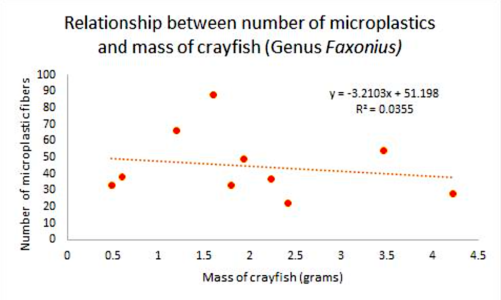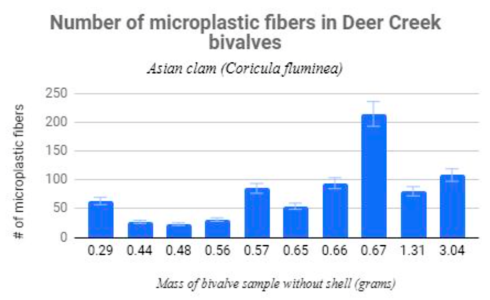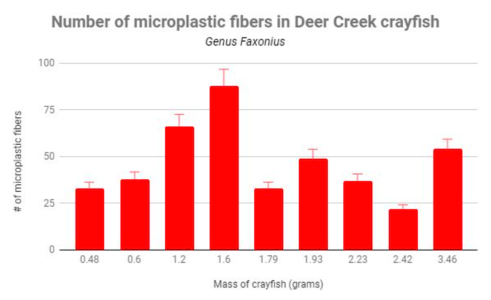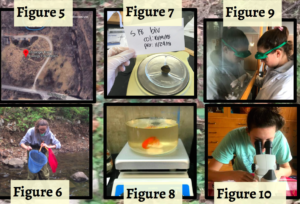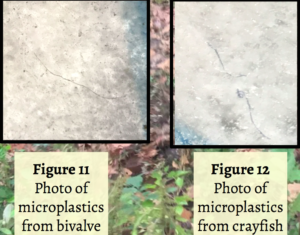Early last fall, LREC was approached by Margie Lodes, a high school junior at St. Joseph’s Academy, about collecting a few crawfish and a some mussels from Deer Creek. After obtaining permission, and a few critters, she began talking about her plans to investigate the presence of microplastics in aquatic ecosystems. Well, I’d never heard of microplastics! Have you?
After submitting her completed project and achieving top 3 recognition at the regional honors science fair, she agreed to share her work with us.
Microplastic Accumulation in Different Trophic Levels from Deer Creek in Suburban St. Louis, MO
By Margie Lodes, St. Joseph’s Academy, Class of 2020

INTRODUCTION
Microplastics are plastics less than 1mm in length/width. They are created through the use of plastics, primarily in clothing and cosmetics. Microplastics can be found on land, in the ocean and in freshwater systems across the globe. Management of plastic waste is a problem, and becomes a greater one the more that plastic usage grows. Though the health impacts of microplastics has yet to be thoroughly explored, this potential danger needs to be researched. An estimated 80% of all microplastic production originates on land, and travels to the oceans through rivers and other freshwater systems. This is why it is vital to conduct research on the microplastic levels in freshwater systems, as they are the major contributors to microplastic accumulation in the ocean. The goal of this project is to provide a snapshot of how widespread these microplastics are.
HYPOTHESIS
If bivalves and crayfish are taken from a single freshwater source in Missouri, then there will be a high level of microplastics in each organism due to human activity, especially in the bivalves as they consume their food directly from the water and microplastics with it.
MATERIALS/METHODOLOGY
- Ten bivalves and ten crayfish were collected from Deer Creek, a freshwater stream in St. Louis County (Missouri), labeled, packaged and stored in a freezer.
- They were then weighed, measured, and placed in 270 mL of water with 30g of KOH in a beaker on a stirring hot plate. Heat was applied and they were left for around 12 hours.
- The remaining liquid was then strained through a 63 micron sieve and the filter washed into a 10 cm diameter, glass petri dish. These were placed into a drying oven, and removed once the liquid had evaporated.
- Finally, gridded paper was placed underneath these petri dishes and the microplastics were counted by the grid square under 20X magnification.
RESULTS
The scatter plots in Figure 1 and Figure 2 show there is little correlation between the size of a sample of bivalve or crayfish and the number of microplastics found.
Figures 3 and 4 show the number of microplastic fibers in ten bivalve and crustacean samples. All samples were contaminated with microplastics, at least 20 fibers.
DISCUSSION/CONCLUSION
This project explored the quantity of microplastics in two different trophic levels: a filter-feeding bivalve species, the Asian Clam (Coricula fluminea) and scavenger crayfish, Genus Faxonius. The results showed that, though there was no clear correlation between the mass of any of the samples and the number of microplastics, there was a high level of microplastics in the samples. A better method of data analysis is being explored because although the number of microplastics was counted, the fibers ranged in size. Had the mass of the microplastics been able to be measured, there may have been a correlation between mass of organism and its plastic load.
In the future, glass jars instead of bags should be used when storing the collected samples as there would be less potential plastic contamination. Masses of the samples should also be taken before the freezing process, and a larger sample group of both species should be collected in order to show a wider data range.
The use of plastics in our consumer society has increased from one-use water bottles to plastic bags to the plastic fibers in textiles. This scientific project will be used to educate the public on the prevalence of plastics in our water waters and even the food supply (crayfish and mollusks are eaten by humans).
ACKNOWLEDGMENTS
I am very thankful for Ms. Britta Baechler of Portland University for the protocol to separate microplastics from bivalves, Mr. Eddie Jones of Litzsinger Road Ecology Center for help with the organism collections, and finally to St. Joseph’s Academy for providing the space and equipment and challenging me to be my best.
FIGURE 5: Google Maps view of collection site, Deer Creek.
FIGURE 6: Collection of the bivalve and crayfish
FIGURE 7: Image of bivalve being weighed and processed
FIGURE 8: A crayfish dissolving in the 10% KOH solution, carpace remains
FIGURE 9: Pouring samples through sieve
FIGURE 10: Using a dissecting scope at 20X magnification to count microplastics
A related report: A Troubling Discovery in the Deepest Ocean Trenches

